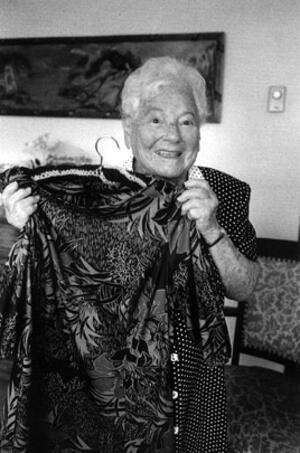Esther Eggleston
Esther Pearl Eggleston was born in St. Louis, Missouri, on September 1, 1905. In 1912, she moved to Seattle with her parents, sisters, and brother. Esther graduated in 1923 from Lincoln High School in Seattle, where she was honored at their 100th-anniversary celebration as the oldest living alumni. In 1934, Esther married Ralph Eggleston, and in 1936, she gave birth to her only child, Annette Joyce. Her husband passed away in 1942, and Esther raised her daughter as a single parent. Esther became the first woman in the United States to serve as executive director of a synagogue when she assumed the position at Temple de Hirsch Sinai in 1943, serving three rabbis and a growing membership of almost a thousand families during her twenty-three years of service. She retired in 1965 and spent her retirement volunteering for various causes, including the American Lung Society, the Jewish Federation, and the National Council of Jewish Women. Esther received the first Esther Eggleston Outstanding Service Award from Women’s American ORT in 1993, now awarded annually in her honor. She passed away at the age of 103 on July 21, 2008, in Seattle, Washington.
Esther talks about her family’s immigration history and family background, her education in the public school system, and experiences of antisemitism growing up. She remembers moving to Seattle with her family in 1912, then a city of horse-drawn buggies, where her father’s family joined Herzl synagogue. Esther remembers feeling “Reform inside” at a young age and ill at ease in Herzl’s Conservative Judaism. As a result, Esther attended Sunday School at Seattle’s oldest and largest Reform Temple de Hirsch, principally comprised of well-heeled German Jews. Here, too, Esther, the daughter of a working-class tailor, felt out of place and cut short her studies before confirmation. She did not affiliate again at Temple until 1944. She describes the sudden death of her husband in 1942 and going to work to support her young daughter – first as secretary and later the first female executive administrator of Temple de Hirsh for the venerated new Rabbi Raphael Levine. The supposed nine-to-five job was, in reality, round the clock. Esther remembers congregants calling her at home in the middle of the night to spare the rabbi his sleep. She was required to work evenings and weekends to help brides at weddings, teenagers during confirmation, and bar mitzvah boys. She feels her painstaking efforts, sacrifices, and contributions were not always acknowledged and that her job was often thankless and undervalued. As the only woman privy to Temple board meetings and decisions, Esther wielded considerable yet unofficial power. She explains how she convinced the Board to grant employees health insurance for the first time, hire professional bookkeepers, purchase an electric grave digger, and create mausoleum space. Esther also persuaded the Board to end the undemocratic practice of allocated seating. Additionally, she welcomed many to Temple who couldn't afford the price of membership nor their children's religious education and always fought for the working person. Esther discusses her life outside of work – her daughter Annette, numerous volunteer and civic activities, baking, and card games with friends. She describes her dedication to the American Women's ORT (Organization for Rehabilitation through Training) and their education programs worldwide. In 1993, Esther was awarded the first annual Esther Eggleston Outstanding Service Award, named thereafter in her honor.



